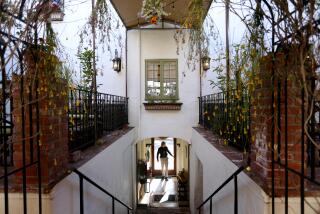LAGUNA BEACH : Planning Board to Reconsider Project
The Planning Commission will reconsider Wednesday a controversial plan to redevelop a downtown site that includes the building that once housed the Fahrenheit 451 bookstore.
The land is owned by Wyland, the artist who painted the “Whaling Wall” alongside the property 13 years ago.
The project has gotten attention partly because the bluff-top property holds three historic structures, the popular old bookstore building and two dilapidated cottages built in 1902.
It’s also the first development proposal up for city approval under the Central Bluffs Specific Plan, which governs construction on about two blocks of choice coastal property south of Main Beach.
“This is the central bluffs, a very visually prominent and important stretch of property in Laguna Beach,” Community Development Director Kyle Butterwick said Monday. “A lot of people are looking at this plan as an example of the type of development the specific plan would allow for.”
While an earlier plan called for all three buildings to be razed, planning commissioners recommended that any redevelopment plan make use of the existing buildings. As a result, the property owner will present a modified proposal Wednesday night.
The new project calls for the old bookstore building to be remodeled, expanded and transformed into an art gallery. Wyland, who uses no first name, is offering to pay to relocate one of the old cottages if a suitable site can be found. The other cottage would be razed and rebuilt to look essentially the same.
Jim Conrad, Wyland’s architect, said Monday he has been lobbying community groups and is “cautiously optimistic” about winning commission approval.
“We’ve done our best to follow the recommendations from the Planning Commission, and we think we’re going to have some support from some of the local community groups,” Conrad said. “It’s a sensitive site; we’re not going to make everybody happy.”
City staff is recommending that the project be rejected.
On Monday, Butterwick questioned whether the one cottage would withstand relocation. He also balked at the prospect of re-creating the other cottage.
“That to me is a very significant issue,” he said. “We speak about historic preservation. Are we speaking about preservation in the literal sense or does preservation mean you can . . . demolish the structure and re-create it? The (city) staff has taken the position that historic preservation means precisely what the term (implies), and that is preservation of historic structures.”
More to Read
Sign up for Essential California
The most important California stories and recommendations in your inbox every morning.
You may occasionally receive promotional content from the Los Angeles Times.










